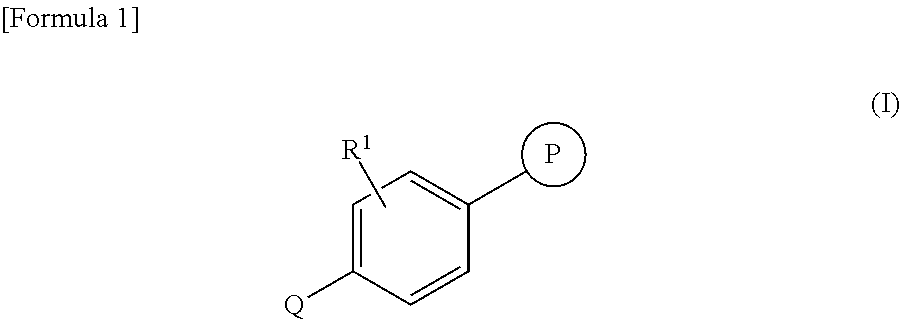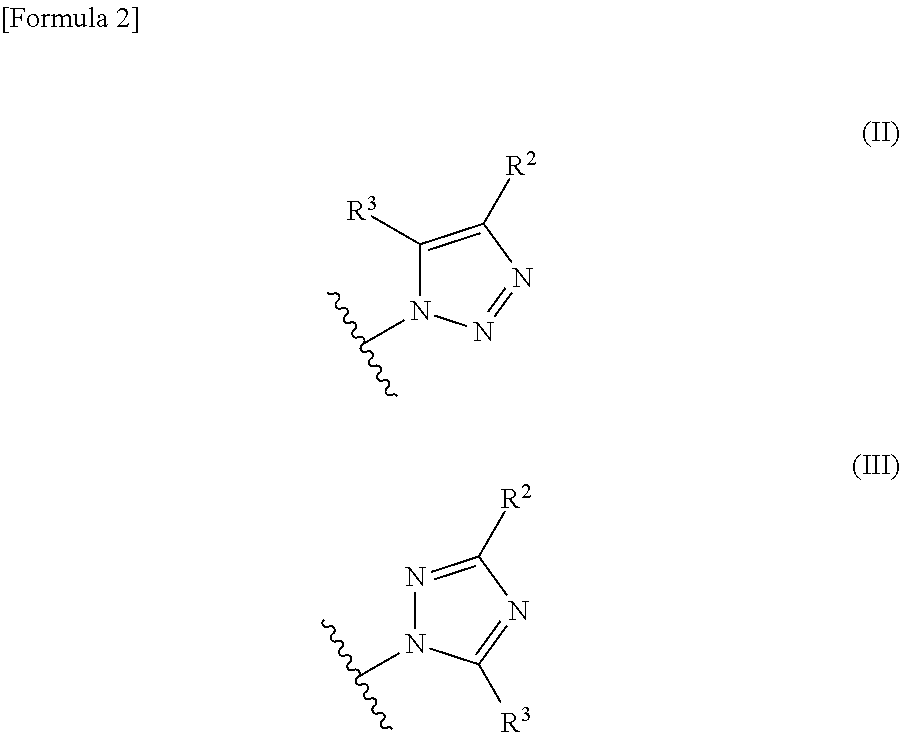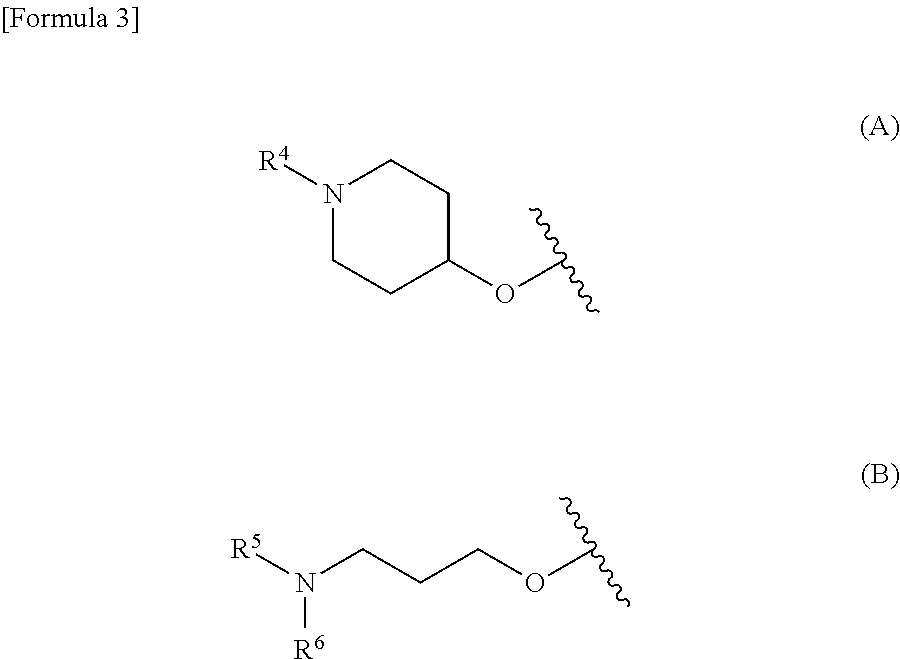Phenyltriazole derivative
a technology of phenyltriazole and derivatives, applied in the field of new drugs, can solve the problems of no report on the structure of compounds, development as medicaments, etc., and achieve the effect of outstanding the antagonistic action of histamine h3 receptor
- Summary
- Abstract
- Description
- Claims
- Application Information
AI Technical Summary
Benefits of technology
Problems solved by technology
Method used
Image
Examples
example 1
Preparation of ethyl 1-{4-[(1-cyclobutylpiperidin-4-yl)oxy]phenyl}-1H-1,2,3-triazole-4-carboxylate (Compound No. 1)
[0112]
[0113]A mixture of 1-cyclobutyl-4-(4-iodophenoxy)piperidine (1.0 g, which can be synthesized according to the method described in WO2008072703), sodium azide (0.32 g), N,N′-dimethylethylenediamine (0.049 g), copper iodide (0.053 g), sodium ascorbate (0.027 g), ethanol (9.0 mL) and water (1.0 mL) was stirred at 70° C. for 2 hours. The reaction mixture was left to cool to room temperature, water was added, and the mixture was extracted with chloroform. The organic layer was concentrated under reduced pressure to give an azide compound based mixture (0.83 g).
MS (EST pos.) m / z: 273 [M+H]+
[0114]A suspension of the residue (0.80 g), ethyl propiolate (576 mg), copper iodide (55.9 mg) and sodium ascorbate (116 mg) in toluene (5.0 mL) was stirred in a sealed tube at 70° C. To the reaction mixture, saturated aqueous sodium hydrogencarbonate was added, and the mixture was ex...
example 2
Preparation of (1-{4-[(1-cyclobutylpiperidin-4-yl)oxy]phenyl}-1H-1,2,3-triazol-4-yl)(pyrrolidin-1-yl)methanone (Compound No. 8)
[0117]
[0118]A mixture of the ethyl 1-{4-[(1-cyclobutylpiperidin-4-yl)oxy]phenyl}-1H-1,2,3-triazole-4-carboxylate (0.070 g) synthesized in Example 1 and pyrrolidine (2.0 mL) was stirred in a sealed tube at 90° C. for 5 hours. The reaction mixture was left to cool to room temperature, saturated aqueous sodium hydrogencarbonate was added, and the mixture was extracted with ethyl acetate. The organic layer was dried over sodium sulfate and then concentrated under reduced pressure. The resulting residue was purified by silica gel column chromatography (NH form silica gel; eluent: n-hexane / ethyl acetate=80 / 20-0 / 100) to give the titled compound as a colorless solid (0.022 g).
[0119]1H NMR (600 MHz, CHLOROFORM-d) δ ppm 1.64-1.77 (m, 2H) 1.80-1.98 (m, 6H) 1.98-2.10 (m, 6H) 2.19 (br. s., 2H) 2.64 (br. s., 2H) 2.75 (d, J=7.84 Hz, 1H) 3.70 (t, J=7.02 Hz, 2H) 4.18 (t, J=6...
example 3
Preparation of 1-{4-[(1-cyclobutylpiperidin-4-yl)oxy]phenyl}-1H-1,2,3-triazole-4-carboxylic acid hydrochloride (Compound No. 17)
[0121]
[0122]A mixture of the ethyl 1-{4-[(1-cyclobutylpiperidin-4-yl)oxy]phenyl}-1H-1,2,3-triazole-4-carboxylate (0.27 g) prepared in Example 1 and concentrated hydrochloric acid (1.0 mL) was stirred at 100° C. for 5 hours. After the reaction mixture was concentrated under reduced pressure, tetrahydrofuran (1.0 mL) was added to the residue, the mixture was stirred at 0° C., and then the precipitate was collected by filtration to give the titled compound as a colorless solid (0.27 g).
[0123]1H NMR (600 MHz, DMSO-d6) δ ppm 1.62-1.83 (m, 2H) 1.87-2.00 (m, 1H) 2.02-2.11 (m, 1H) 2.12-2.22 (m, 3H) 2.26 (d, J=13.21 Hz, 1H) 2.30-2.42 (m, 2H) 2.80-3.01 (m, 2H) 3.19-3.28 (m, 1H) 3.56-3.67 (m, 1H) 3.69-3.80 (m, 1H) 4.62-4.92 (m, 1H) 7.17-7.28 (m, 2H) 7.82-7.97 (m, 2H) 9.30 (s, 1H) 10.85 (br. s., 1H) 13.29 (br. s., 1H); MS (ESI pos.) m / z: 343 [M+H]+
PUM
 Login to View More
Login to View More Abstract
Description
Claims
Application Information
 Login to View More
Login to View More - R&D
- Intellectual Property
- Life Sciences
- Materials
- Tech Scout
- Unparalleled Data Quality
- Higher Quality Content
- 60% Fewer Hallucinations
Browse by: Latest US Patents, China's latest patents, Technical Efficacy Thesaurus, Application Domain, Technology Topic, Popular Technical Reports.
© 2025 PatSnap. All rights reserved.Legal|Privacy policy|Modern Slavery Act Transparency Statement|Sitemap|About US| Contact US: help@patsnap.com



